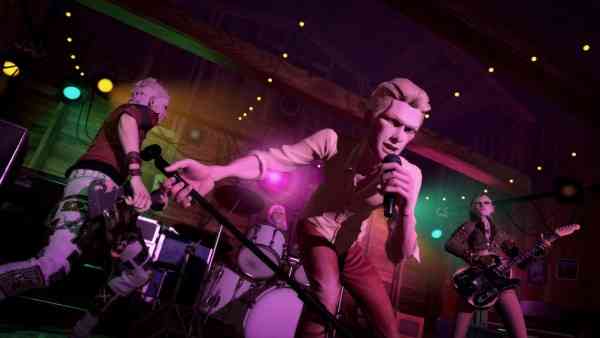Presentation/Career Mode
Guitar Hero Live
GHL’s presentation is a drastic departure from past games. Gone are the days of cartoony characters and seeing your characters in third person. The single player is now played in first person using full motion video (FMV) with real crowds and bandmates that react to how you play. It’s an interesting way to play the game, but I ultimately felt disconnected from the band I was playing with largely because the band you play with changes every set. On top of that there’s no backstory to who these people are and what makes them tick. Also the facial expressions and acting on stage can be a little over the top.
The career mode is what you would expect. You play through two music festivals through different themed sets. Once you complete the career mode there isn’t much to go back for. The career can be completed in one sitting since there are only 42 songs on disc.
Rock Band 4
RB4 doesn’t look drastically different from RB3. The presentation is on par to what you’ve seen before. There are a few subtle changes here and there, such a timer that will count you into a song and a new note highway that features shinier gems. The career mode on the other hand is awesome. The career mode features branching story lines that allow you to choose your path as a band. I’ve already played through the career mode several times and can’t get enough of it.
Multiplayer/Online Play
Guitar Hero Live
GHL features offline play for up to three people if you’re playing with a vocalist. The local multiplayer is medicore and doesn’t allow the second player to play rhythm guitar or bass. Both guitarists play the same guitar chart, which is disappointing. I’ve never really enjoyed Guitar Hero’s vocal engine and I feel the same way about GHL. It’s less forgiving than RB4 and you can’t sing vocal harmonies with other players.
The best feature of GHL is GHTV – a 24/7 music streaming service that feels reminiscent of MTV in the 80’s and 90’s. The service also features premium shows that allow you to play several songs from a specific artist or genre to live concert footage or the music video. GHTV also features an on-demand service that lets you choose any song to play from the game’s service at anytime. As I mentioned before, the biggest problem with GHTV is that you cannot download any songs like you can in RB4 and the service is littered with microtransactions. On the bright side, the game is fairly generous and you can get away without having to pay for any content if you don’t want to.
Activision plans on updating the service weekly and is hoping to have at least 70 new songs available on the service by year’s end. To celebrate Halloween, Activision has a new show running on the TV channels called Halloween Rocks, which features artists whose music resembles the darkness of the holiday.
Rock Band 4
Rock Band 4 features no online play, but still allows players to play as a 6 piece band in the same living room. Playing with other people is where RB4 is at its best. Harmonix also continues its tradition of releasing weekly DLC for Rock Band 4. Harmonix has hinted that online play could be added down the road in a patch. As previously mentioned, Harmonix has hinted that their upcoming patch on December 8th would feature some new competitive features. One of my favourite game modes missing from Rock Band 3 and 4 were score duel and tug of war, so hopefully they make a re-appearance down the road.
Summary
Both games are great, but it’s important to note that at the same time these games couldn’t be more different. Which game you should buy is largely dependent on your musical taste, what instrument you play, how many people you play with and how you want to consume music.
Regardless of what camp you’re in, music fans have a lot to look forward to in the coming years with both games offering weekly content upgrades.

